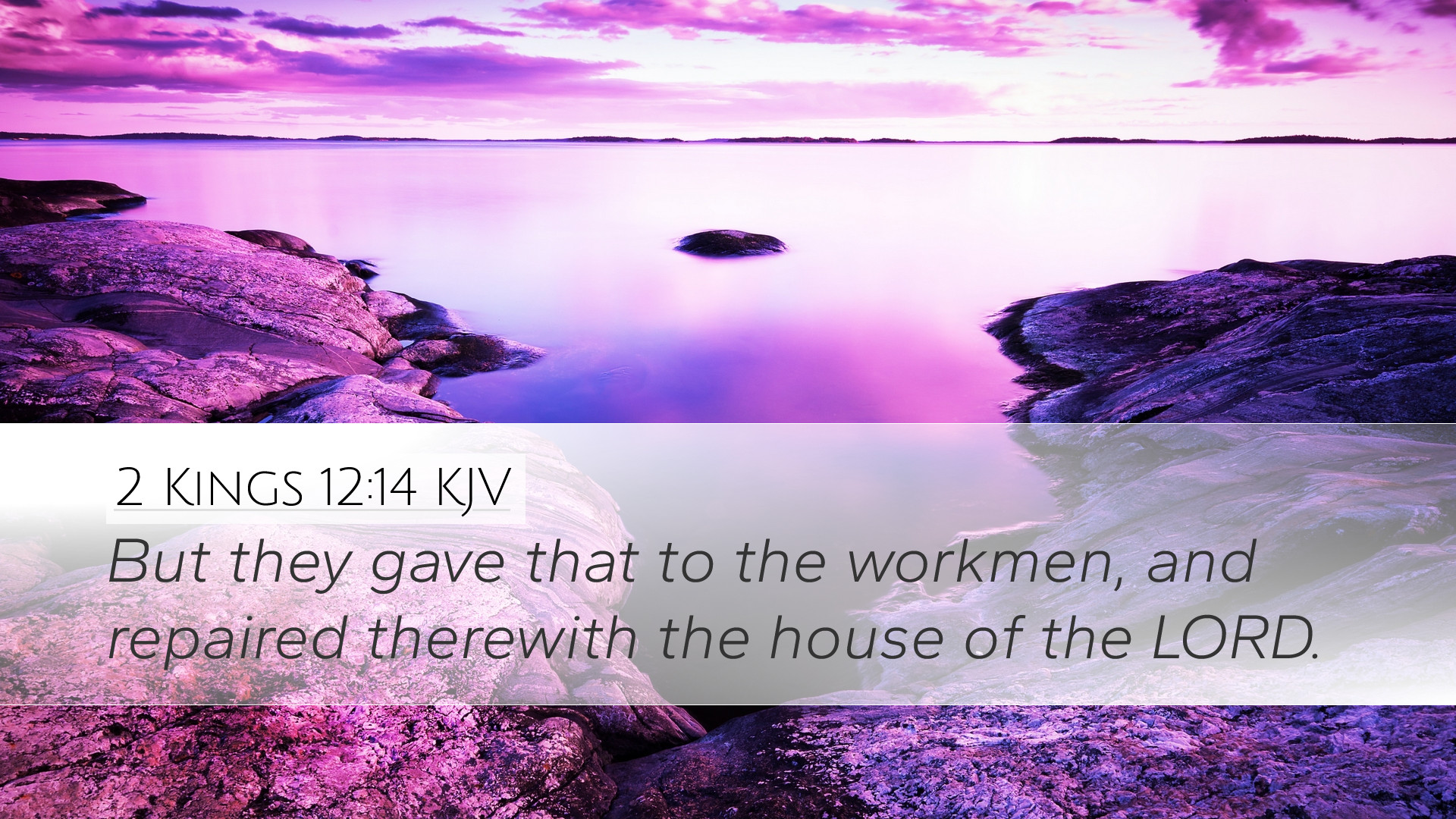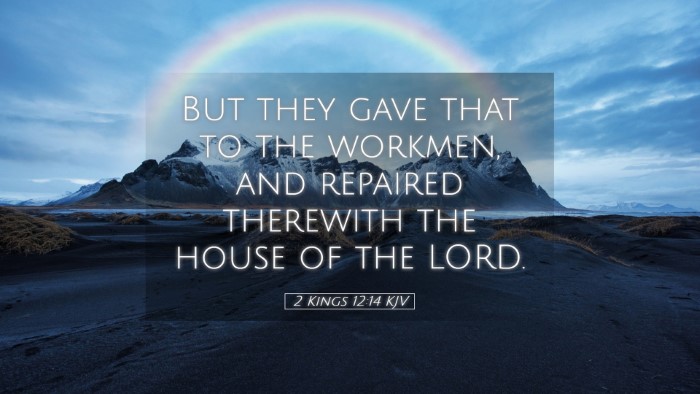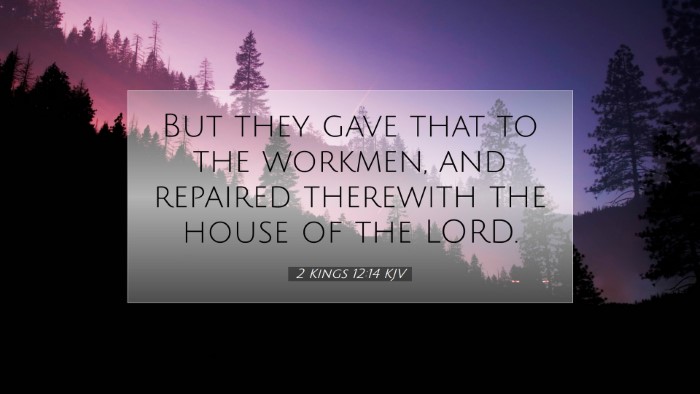Old Testament
Genesis Exodus Leviticus Numbers Deuteronomy Joshua Judges Ruth 1 Samuel 2 Samuel 1 Kings 2 Kings 1 Chronicles 2 Chronicles Ezra Nehemiah Esther Job Psalms Proverbs Ecclesiastes Song of Solomon Isaiah Jeremiah Lamentations Ezekiel Daniel Hosea Joel Amos Obadiah Jonah Micah Nahum Habakkuk Zephaniah Haggai Zechariah Malachi2 Kings 12:14
2 Kings 12:14 KJV
But they gave that to the workmen, and repaired therewith the house of the LORD.
2 Kings 12:14 Bible Commentary
Commentary on 2 Kings 12:14
Bible Verse: "But they gave that which was set apart to the work of the house of the Lord to the builders and to the masons, and to those who worked with iron and bronze to repair the house of the Lord."
Introduction
The context of 2 Kings 12 discusses the reign of King Joash (also known as Jehoash), who initiated significant reforms in Judah, particularly concerning the temple's restoration. This verse highlights the actions taken to gather and allocate resources for the repair of the temple, emphasizing a dedication to the Lord's house.
Historical Context
Joash ascended to the throne as a child and was influenced by the high priest Jehoiada, who played a pivotal role during his early reign. The temple, once a place of worship and divine encounter, had fallen into disrepair due to neglect and apostasy fostered during the reigns of previous kings. This verse serves as a reflection of Joash's conviction to restore not only the physical structure but also the spiritual vitality of Israel by revitalizing worship practices centered at the temple.
Exegetical Insights
-
Allocation of Resources:
The verse illustrates the practical aspect of temple restoration, indicating a structured allocation of resources. This reflects the orderly process by which the Israelites approached their worship and service to God, recognizing the need to provide for those tasked with the work of the Lord's house.
-
Craftsmanship and Dedication:
The mention of builders, masons, and metalworkers underscores the importance of skilled labor in fulfilling God's work. Each worker contributes unique talents, symbolically representing the diverse gifts within the body of Christ (1 Corinthians 12:12-27). The church today can glean from this that engaging skilled individuals in ministry is essential for effective service.
-
Spiritual Responsibility:
The act of repairing the temple is not merely physical labor; it carries profound spiritual significance. The temple represented God’s presence among His people. By restoring the temple, Joash and his assembly reaffirmed their commitment to God’s covenant, portraying a physical manifestation of their spiritual responsibilities as guardians of their faith.
Theological Reflections
-
God's House:
This passage serves as a reminder that God's house holds sacred value. The term "house of the Lord" evokes the essence of worship and the community's collective identity as God's chosen people. Today's believers are called to honor their congregations' physical spaces, ensuring that they are conducive to worship, teaching, and fellowship.
-
Restoration as a Theme:
The theme of restoration resonates throughout Scripture. Just as Joash prioritized the repair of the temple, so too are believers called to seek the restoration of their own spiritual lives and communities. This can involve repentance, renewal of commitment, and a rediscovery of the centrality of worship in the life of the church.
-
Community Participation:
The collective effort described in the verse emphasizes community engagement in fulfilling God's mission. Just as the people came together to provide and support the repair of the temple, so the church today is encouraged to unite in pursuit of ministry endeavors, reflecting the importance of working together toward common goals aligned with God's purposes.
Insights from Commentators
-
Matthew Henry:
Henry notes that Joash's reforms included not just the repair of the physical building but also the restoration of proper worship practices. He emphasizes the attitude with which the resources were given, highlighting that it must stem from a true desire to honor God. Such a perspective invites reflection on our motivations in ministry and service.
-
Albert Barnes:
Barnes elaborates on the notion of dedicated offerings and the importance of accountability in stewardship. He suggests that all offerings to God should be made with transparent intentions, ensuring that resources are utilized for His glory. This invites pastoral leaders to maintain integrity in financial matters within their ministries.
-
Adam Clarke:
Clarke emphasizes the historical significance of this repair work, linking it to the spiritual revival taking place during Joash's reign. He notes that physical structures should not overshadow the necessity of spiritual renewal within the community. This viewpoint encourages theologians and church leaders to focus on the spiritual healing that accompanies physical restoration.
Practical Applications
-
Encourage Stewardship:
Church leaders should foster a culture of stewardship among their members where resources—be it time, talent, or treasure—are viewed as contributions to the work of God. Just as the Israelites provided for the temple, individuals should be motivated to support initiatives within their church community.
-
Commitment to Repair:
Just as the temple required repair, modern congregations must address areas of neglect within their programmatic and spiritual life. Pastors should lead congregants in identifying and addressing these areas while fostering a vision for restoration.
-
Involve Everyone:
The passage encourages inclusivity in ministry operations, inviting all members of the congregation to participate in various capacities. Leaders should actively seek out opportunities for members to contribute, ensuring that everyone's gifts are recognized and utilized.
Conclusion
2 Kings 12:14 challenges and inspires believers to actively participate in the upkeep and enhancement of their worship spaces and practices. It sparks a dialogue about priorities in ministry, stewardship, and community. As pastors, students, and theologians reflect on this verse, may they gain deeper insights into their responsibilities toward God's house and the vital role of communal involvement in the life of the church. The act of aligning both physical and spiritual restoration can lead to a profound renewal of faith within congregations.


